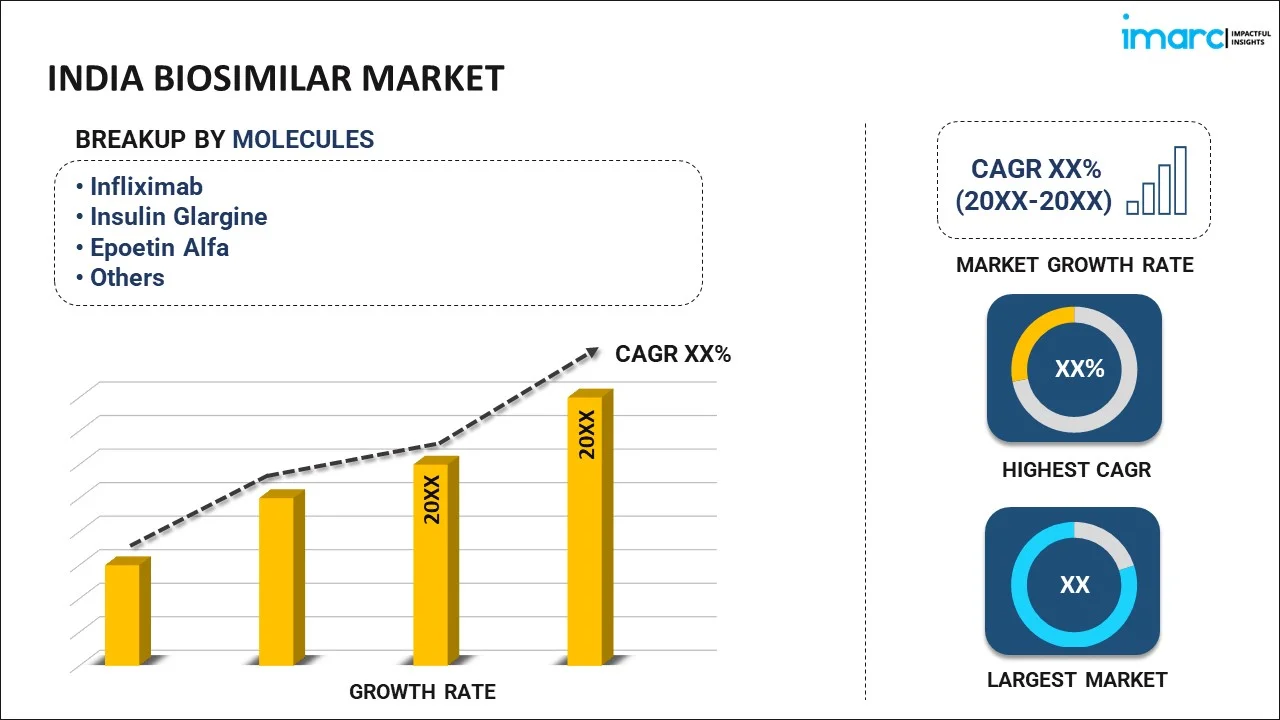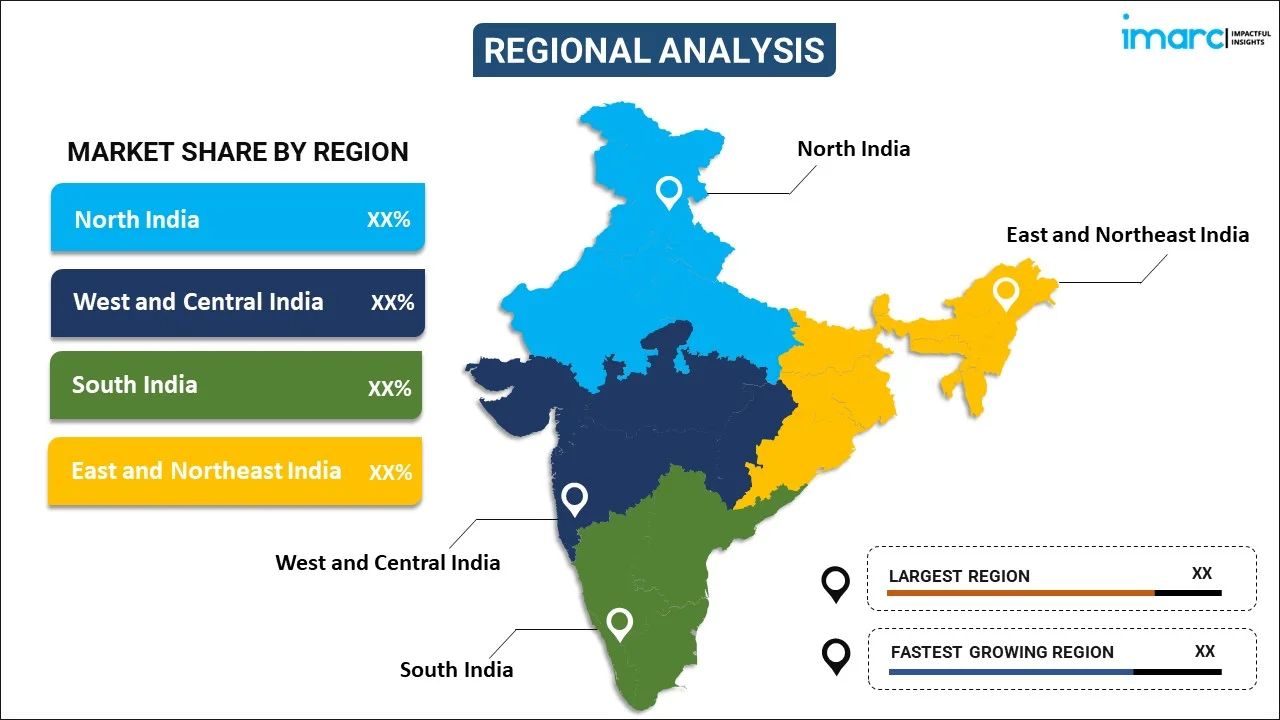
India Biosimilar Market Report by Molecule (Infliximab, Insulin Glargine, Epoetin Alfa, Etanercept, Filgrastim, Somatropin, Rituximab, Follitropin Alfa, Adalimumab, Pegfilgrastim, Trastuzumab, Bevacizumab, and Others), Indication (Auto-Immune Diseases, Blood Disorder, Diabetes, Oncology, Growth Deficiency, Female Infertility, and Others), Manufacturing Type (In-house Manufacturing, Contract Manufacturing), and Region 2025-2033
Market Overview:
India biosimilar market size reached USD 866.2 Million in 2024. Looking forward, IMARC Group expects the market to reach USD 3,662.9 Million by 2033, exhibiting a growth rate (CAGR) of 17.38% during 2025-2033. The growing prevalence of chronic diseases, such as cancer, autoimmune disorders, and diabetes, which has led to an increased demand for biologic drugs, is driving the market.
|
Report Attribute
|
Key Statistics
|
|---|---|
|
Base Year
|
2024 |
|
Forecast Years
|
2025-2033
|
|
Historical Years
|
2019-2024
|
| Market Size in 2024 | USD 866.2 Million |
| Market Forecast in 2033 | USD 3,662.9 Million |
| Market Growth Rate (2025-2033) | 17.38% |
A biosimilar is a biological product that is highly similar to and has no clinically meaningful differences from an existing approved reference biological product. Unlike generic versions of small-molecule drugs, which are identical copies, biosimilars are complex molecules produced from living organisms. The development of biosimilars involves thorough analytical and clinical testing to demonstrate similarity in terms of safety, efficacy, and quality to the reference product. While biosimilars provide cost-effective alternatives to expensive biological drugs, they are not identical replicas due to the inherent complexity of biological products. Regulatory agencies play a crucial role in evaluating and approving biosimilars to ensure they meet rigorous standards and provide a safe and effective alternative to the reference biologic.
India Biosimilar Market Trends:
The biosimilar market in India is propelled by several key drivers, creating a dynamic landscape for these biologic alternatives. Firstly, increasing demand for cost-effective treatment options is a significant catalyst. As healthcare expenditures continue to rise, biosimilars offer a more affordable alternative to their reference biologics, expanding patient access to critical therapies. Moreover, regulatory support has played a pivotal role in driving market growth. Regulatory agencies, recognizing the potential for biosimilars to enhance competition and reduce healthcare costs, have implemented streamlined approval pathways, fostering a favorable environment for market expansion. Furthermore, the aging population contributes to the market's upward trajectory, as older individuals typically require a higher volume of biological treatments. This demographic shift has intensified the need for cost-efficient solutions, positioning biosimilars as a strategic response to this demographic challenge. Additionally, advancements in biotechnological research and manufacturing capabilities have bolstered the development and production of biosimilars, further fueling market growth. As innovation continues to enhance the quality and reliability of biosimilar products, the market is poised to play an increasingly prominent role in addressing the evolving healthcare landscape. In essence, the convergence of economic, regulatory, demographic, and technological factors propels the biosimilar market forward in India, offering a promising future for accessible and affordable biologic therapies.
India Biosimilar Market Segmentation:
IMARC Group provides an analysis of the key trends in each segment of the market, along with forecasts at the country level for 2025-2033. Our report has categorized the market based on molecule, indication, and manufacturing type.
Molecule Insights:

- Infliximab
- Insulin Glargine
- Epoetin Alfa
- Etanercept
- Filgrastim
- Somatropin
- Rituximab
- Follitropin Alfa
- Adalimumab
- Pegfilgrastim
- Trastuzumab
- Bevacizumab
- Others
The report has provided a detailed breakup and analysis of the market based on the molecule. This includes infliximab, insulin glargine, epoetin alfa, etanercept, filgrastim, somatropin, rituximab, follitropin alfa, adalimumab, pegfilgrastim, trastuzumab, bevacizumab, and others.
Indication Insights:
- Auto-Immune Diseases
- Blood Disorder
- Diabetes
- Oncology
- Growth Deficiency
- Female Infertility
- Others
A detailed breakup and analysis of the market based on the indication have also been provided in the report. This includes auto-immune diseases, blood disorders, diabetes, oncology, growth deficiency, female infertility, and others.
Manufacturing Type Insights:
- In-house Manufacturing
- Contract Manufacturing
The report has provided a detailed breakup and analysis of the market based on the manufacturing type. This includes in-house manufacturing and contract manufacturing.
Regional Insights:

- North India
- West and Central India
- South India
- East and Northeast India
The report has also provided a comprehensive analysis of all the major regional markets, which include North India, West and Central India, South India, and East and Northeast India.
Competitive Landscape:
The market research report has also provided a comprehensive analysis of the competitive landscape in the market. Competitive analysis such as market structure, key player positioning, top winning strategies, competitive dashboard, and company evaluation quadrant has been covered in the report. Also, detailed profiles of all major companies have been provided.
India Biosimilar Market Report Coverage:
| Report Features | Details |
|---|---|
| Base Year of the Analysis | 2024 |
| Historical Period | 2019-2024 |
| Forecast Period | 2025-2033 |
| Units | Million USD |
| Scope of the Report | Exploration of Historical Trends and Market Outlook, Industry Catalysts and Challenges, Segment-Wise Historical and Future Market Assessment:
|
| Molecules Covered | Infliximab, Insulin Glargine, Epoetin Alfa, Etanercept, Filgrastim, Somatropin, Rituximab, Follitropin Alfa, Adalimumab, Pegfilgrastim, Trastuzumab, Bevacizumab, Others |
| Indications Covered | Auto-Immune Diseases, Blood Disorder, Diabetes, Oncology, Growth Deficiency, Female Infertility, Others |
| Manufacturing Types Covered | In-house Manufacturing, Contract Manufacturing |
| Regions Covered | North India, West and Central India, South India, East and Northeast India |
| Customization Scope | 10% Free Customization |
| Post-Sale Analyst Support | 10-12 Weeks |
| Delivery Format | PDF and Excel through Email (We can also provide the editable version of the report in PPT/Word format on special request) |
Key Questions Answered in This Report:
- How has the India biosimilar market performed so far and how will it perform in the coming years?
- What has been the impact of COVID-19 on the India biosimilar market?
- What is the breakup of the India biosimilar market on the basis of molecule?
- What is the breakup of the India biosimilar market on the basis of indication?
- What is the breakup of the India biosimilar market on the basis of manufacturing type?
- What are the various stages in the value chain of the India biosimilar market?
- What are the key driving factors and challenges in the India biosimilar?
- What is the structure of the India biosimilar market and who are the key players?
- What is the degree of competition in the India biosimilar market?
Key Benefits for Stakeholders:
- IMARC’s industry report offers a comprehensive quantitative analysis of various market segments, historical and current market trends, market forecasts, and dynamics of the India biosimilar market from 2019-2033.
- The research report provides the latest information on the market drivers, challenges, and opportunities in the India biosimilar market.
- Porter's five forces analysis assist stakeholders in assessing the impact of new entrants, competitive rivalry, supplier power, buyer power, and the threat of substitution. It helps stakeholders to analyze the level of competition within the India biosimilar industry and its attractiveness.
- Competitive landscape allows stakeholders to understand their competitive environment and provides an insight into the current positions of key players in the market.
Need more help?
- Speak to our experienced analysts for insights on the current market scenarios.
- Include additional segments and countries to customize the report as per your requirement.
- Gain an unparalleled competitive advantage in your domain by understanding how to utilize the report and positively impacting your operations and revenue.
- For further assistance, please connect with our analysts.

 Inquire Before Buying
Inquire Before Buying
 Speak to an Analyst
Speak to an Analyst
 Request Brochure
Request Brochure
 Request Customization
Request Customization



.webp)




.webp)












